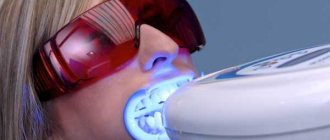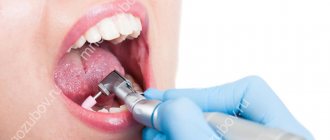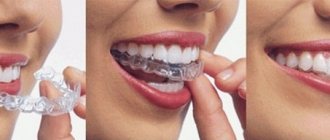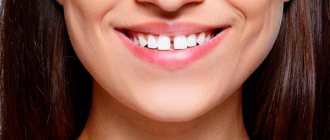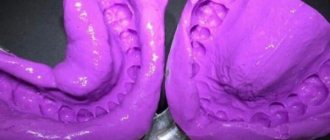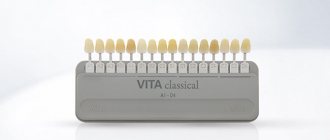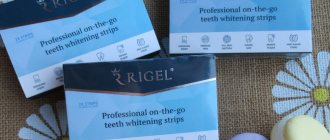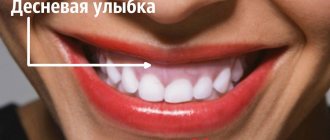What colors of teeth are there?
As a rule, the color of tooth enamel is milky white and translucent, but over the course of life, the tissue can become stained under the influence of various factors. The color of teeth depends not only, or rather not so much, on the enamel, but on the shade and quality of dentin, which shines through the enamel. The younger the person, the denser the layer of enamel on his teeth. In addition, the surface of the tooth is uneven, which means the light is reflected unevenly. The denser the layer of enamel is on the teeth and the more pronounced its surface microrelief, the less it shines through, and, therefore, the tooth looks whiter. Conversely, with age, the tooth surface smoothes out, the enamel layer decreases, and dentin begins to shine through more and more, the natural color of which is much darker than the enamel and can be light brown, yellow or gray. With age, the amount of enamel decreases, dentin also undergoes changes, and red-brown pulp begins to shine through the surface structures of the tooth, therefore, the teeth themselves acquire darker shades. It should be taken into account that dental tissues are usually colored unevenly over their surface: at the cutting edge the color is lighter than at the root. Different teeth also have different shades. For example, canines are often darker than incisors. Today, all age-related changes in the color of teeth are easily corrected by aesthetic dentistry, as well as any other problems associated with the appearance of the dentition.
Types of plaque
- White.
By the end of the day, all children have a small amount of harmless white residue. Abundant formation indicates vitamin deficiency, reduced immunity or insufficient hygiene. This type of plaque can be removed from a child’s teeth if you brush your teeth thoroughly every day. The presence of hard fruits and vegetables in the diet, such as apples and carrots, promotes mechanical cleaning. If no action is taken, the layer will harden, mineralize and turn into tartar.
- Yellow.
Indicates insufficient hygiene and poor nutrition. In children under two years of age, it can occur, for example, due to the consumption of sweet liquids from a bottle. It may also indicate the initial stage of caries. By choosing the right toothpaste and brush, as well as brushing your teeth more thoroughly, this problem can be solved.
- From light gray to green.
Gray - possible with abundant release of chlorophyll, sometimes acquires a greenish tint. Green - provoked by a fungus - chromogenic bacteria. Damages the pellicle, the natural protective film on the teeth. Only a dentist can help remove such plaque.
- Brown.
Indicates a fungal infection of the oral cavity and a disorder in the gastrointestinal tract. The result is darkening of the enamel. Iron supplements can also stain teeth brown. How to remove such plaque from a child’s teeth? Sometimes it goes away on its own after you stop taking iron-containing foods or medications. If the deposits have hardened, you will need professional teeth cleaning - ultrasound or chemical whitening. It is also necessary to adjust the child’s nutrition.
- Black.
Black plaque is the first harbinger of caries. Especially if it has a point character. In such cases, it is better not to postpone a visit to the dentist.
Natural tooth color
Speaking about the natural color of teeth, one cannot fail to mention the characteristics of people with different skin tones. For example, during a recent comparative study of representatives of the Slavic and Iranian groups, scientists identified such a feature. People of the Slavic and Iranian groups most often have a red-brown tint of teeth, less often - reddish-gray. At the same time, among the Slavs, teeth can also be reddish-yellow, but among Iranians, this color was not found in the color of the teeth, as well as gray - in both one and the other group. A comparative analysis of other nationalities shows similar results, indicating that the color of teeth is largely influenced by genetic characteristics and, to a lesser extent, by the environment in which a person lives.
Many people think that people with black skin have beautiful white teeth, but most often this is not the case. African Americans' smiles simply appear brighter. A similar effect, by the way, is observed in tanned people, even those who have only spent a little time in the sun. Therefore, when answering the question of what color natural teeth should be, one should rely on many factors, including those listed above.
By the way, the American Dental Association claims that teeth with a yellowish tint are easiest to whiten. In second place is the brownish tint of the enamel, and the worst response to the whitening procedure is gray teeth, which are often found among Americans.
What to do for preventive purposes
- The diet should be balanced with sufficient amounts of calcium, fluorine, and phosphorus.
- It is necessary to include raw hard fruits and vegetables in the diet, and reduce the amount of sugar-containing foods.
- After each meal, rinse your mouth with plain water, and in the morning and evening, thoroughly brush your teeth.
- Reduce the number of daytime snacks and, if possible, eliminate night meals.
- Visiting your dentist at least twice a year will help you identify causes that contribute to plaque formation, such as a bad bite, chewing on one side, or damage to your gums or enamel.
- It is important to choose the right toothbrush and change it every three months. Choosing age-appropriate toothpaste is also important.
- It is recommended to eliminate such bad parental habits as tasting the child’s food with his own spoon or licking the baby’s pacifier. If an adult's saliva gets into a child's mouth, it can worsen the condition of his teeth, since the composition of saliva in children and adults is different.
Examine your child's mouth frequently to spot problems early. Do not try to remove plaque yourself, as you can cause even more harm, because the child’s teeth are sensitive and the enamel is very thin. Only a doctor can answer the question of how to remove plaque from a child’s teeth. Having correctly diagnosed, he will prescribe adequate treatment.
How to choose teeth color
The practice of an orthopedic dentist involves the need to choose the shade of dentures. When making prosthetics or restoring one or more teeth in a row, the color is selected in accordance with the patient’s natural teeth. When making complete removable or fixed orthopedic structures, the patient has the opportunity to choose the desired color of the teeth. In this case, you should focus not only on your own desires, but also on the shade of your skin, hair and eye whites. Typically, teeth that are much lighter than the whites of the eyes look unnatural and stand out too much when you smile. In addition, the material from which the crowns or veneers are made should also be taken into account. Thus, plastic and composite materials used to restore teeth look different than metal-ceramics, even with the same color index.
Please note that the color of teeth will be perceived differently in different lighting conditions. That is why, when choosing the shade of veneers or dentures, it is necessary to follow a whole list of conditions, such as natural light, neutral color of the walls in the room and the clothes of the patient and the doctor, the absence of bright lipstick on the lips, and so on.
Why do children's teeth turn black?
If dark streaks appear on a child's teeth, this indicates the formation of Presley plaque on the teeth. The appearance of this plaque is associated with the age-related development of the child’s digestive system.
Other causes of black plaque on a child’s teeth:
- Formation of dark biofilm.
- Development of caries.
- Lack of calcium in the body.
- Genetic inheritance.
- Wrong diet, which contains a lot of sweet foods and soda.
- Excess sugar in the body contributes to the formation of biofilm on the enamel.
Definitions of tooth color
When making dentures, technicians are guided by a special tooth color chart. According to the Vita scale, which is used by almost all dental clinics in the world, natural teeth can have only a few shades: brown, yellow, gray and red. Depending on the intensity category, colors are designated by numbers from 1 to 4. Thus, if a dentist talks about tooth color under the index A1, he means the lightest shade from the reddish-brown range of the table, accordingly, A2 will be slightly darker, A3 - even darker. Index B corresponds to the yellow tone of the teeth and varies in the same way according to the lightness of the shades (B1, B2, and so on). The gray shade is indicated by the Latin letter C (C1, C2, and so on), and reddish-gray teeth - D (namely Latin, not Russian D). The numerical index of the scale indicates the intensity of the color and starts from one, so tooth color 0 actually does not exist.
Why do adults' teeth turn black?
- Complete neglect of dental hygiene , which results in increased formation of plaque. Plaque gradually turns into stone, which is a breeding ground for pathogenic bacteria. These bacteria, penetrating into the deep layers of the soft tissues of the tooth, destroy the pulp, which causes the enamel to turn green and then black.
- Caries. Black dots and spots that appear on the enamel signal the development of caries. If this dental disease is not treated in a timely manner, the carious cavity begins to expand, destroys the enamel, which causes its darkening.
- Pulpitis. Pulp damage is a serious disease in which the supply of nutrients to the tooth through the blood vessels located in the pulp may be interrupted. Dead pulp tissue can change the color of the enamel.
- Periapical granuloma occurs when inflammation occurs in the granulation tissue. In this case, granuloma grows, which can develop phlegmon, abscess, and osteomyelitis. The damaged tooth darkens and must be treated immediately so that it does not have to be removed.
- Smoking and drinking alcoholic beverages can disrupt the pigmentation of enamel.
- Food colorings. Some foods and drinks contain pigments that can change the color of your teeth.
- Taking tetracycline drugs can cause yellowing of teeth.
- Flurosis is a dental disease that develops from an excess of fluoride in the body. Flurosis leads to thinning of the enamel and its destruction. For preventive purposes, tooth enamel is remineralized, and it is recommended not to use pata with a high fluoride content.
- Removing the nerve of a tooth can cause the tooth to turn black. This happens because the supply of nutrients to the tooth stops and the tooth tissues die.
Treatment of darkened pulpless teeth
Since dead teeth cannot receive nutrition through the roots, doctors resort to intracanal whitening (endo-whitening). To do this, the dentist opens the canal, cleans it well, and then fills it with whitening gel and closes it with a temporary filling. If the degree of blackening of the unit is large, then the procedure can be repeated after two weeks (but no more than four times in a row).
On a note! Endobleaching is not recommended for pregnant or breastfeeding women and children under 16 years of age. Intra-canal whitening is also contraindicated in patients with tooth sensitivity or allergies to hydrogen peroxide.
Another way to solve the problem is to install veneers (lumineers). These are plates that the doctor glues to the visible side of the crown with special glue. Modern dentistry offers a large selection of veneers made of ceramics, zirconium, and composite materials. However, this method of treatment has its contraindications (gum disease, mobility or destruction of the unit, etc.), which should be taken into account when discussing tactics for treating darkened enamel.
Making a crown is another common method of treating darkened, pulpless teeth. It allows not only to restore the unit’s aesthetic appearance, but also to protect it from further destruction. The tooth is ground, polished, and then, using a plaster cast, the dentist makes a crown, which is then placed on the prepared unit. In modern dentistry, the most popular crowns are made of metal-ceramics or ceramics with a porcelain base - due to their closeness to the natural color of the enamel.
Read on the topic: Prosthetics of anterior teeth - which crowns to choose to preserve the aesthetics of your smile.
Restoration is a labor-intensive and short-lived way to solve the problem. This method is based on the fact that the darkened part of the crown is covered with filling material, restoring the aesthetics of the smile. However, the service life of such fillings is short, and the procedure must be repeated again and again.
Symptoms of bruise
The symptoms of a severe bruise are obvious and easy to recognize. The area where the mechanical impact occurred causes unpleasant and painful sensations in the child. Children complain of severe pain when chewing food.
There are other common symptoms that can help diagnose a bruise:
- Hemorrhage is observed, due to which the enamel may turn pink. This occurs due to ruptures of blood vessels and tissues at the tooth base.
- A baby tooth darkened after a blow to a child, this is due to the fact that the periodontal tissue was injured. The periodontium is a complex of tissues that surround and hold human teeth in the alveolar area.
- There is slight loosening of the tooth. Although it is not too strong, it can be a symptom of damage to the alveolar bone. Untreated trauma to baby teeth can cause irreversible consequences that will negatively affect the formation of permanent teeth.
- There may be redness and swelling in the area where the main impact was made. The hematoma can be pronounced, or can only be detected by palpation. In any case, when you lightly press it, the child experiences pain and discomfort.
- A strong blow can lead to a more serious injury - a fracture of the alveolar process. If it is present, a person cannot make the usual movements of the jaw; when closing and opening the jaw, severe pain is observed.
- Ligament rupture resulting from a blow causes pain not only in the damaged area, but throughout the entire surface of the jaw. The child refuses to eat and becomes capricious.
In order to identify a bruise in a child, parents should closely monitor the health of their children. It is advised to pay due attention to every complaint that in one way or another may be related to the state of health.
Taking medications
Darkening of the enamel is a side effect of some medications. Most often these are drugs that are prescribed for iron deficiency anemia (Fenuls, Totema, etc.). They contain gluconates of manganese, copper and iron dihydrate, which cause tissue pigmentation, and since the drugs are used in liquid form, the teeth are the first to take the blow.
Attention! To avoid staining the enamel when taking iron-containing medications, you need to use a drinking straw. At the same time, it is important that it also does not come into contact with the teeth.
Another group of drugs that can deprive crowns of their natural color are tetracycline antibiotics. Most often, this pathology manifests itself in children whose mothers took oxytetracycline, metacycline, minocycline, etc. during pregnancy.
How is a bruise diagnosed?
How to behave if a child’s tooth has darkened after a blow? Try to remain calm, the child needs to be shown to the dentist urgently. The doctor will order an x-ray examination, on its basis it will be possible to make a diagnosis. A visual inspection of the damaged area is also performed, the severity of the injury is determined and treatment is prescribed.
The attending physician will tell you how long it will last and by what means it will be performed. Be sure to insist on an x-ray examination, because only an x-ray can reveal all possible disorders and consequences that the injury could lead to.
An impact may result in a fracture of the tooth root, or significant trauma to the alveolar process. These injuries are dangerous and without appropriate treatment can cause irreparable harm not only to baby teeth, but also to permanent teeth.
The first days, treatment should take place under the close supervision of a doctor. The doctor continues to examine the affected area and at the first symptoms of tissue death, immediately removes the affected parts. This prevents further spread of necrosis.
Causes of tooth bruise
As with any mechanical impact, a tooth bruise can be caused by a number of reasons.
There are several of the most common cases that can result in such an injury:
- In the process of playing sports, a tooth can be injured in an accident. For example, when playing football, the ball may fly out unsuccessfully and hit the child in the jaw area. Such an injury can be serious, and the bruise will be noticeable on the external surface.
- A car accident also often causes a tooth bruise. In a car accident, you can suffer a large number of injuries of various types. And even if everything turned out well at first glance, the child in any case must be taken to the doctor.
- Domestic trauma is perhaps the most common cause of severe injury. Moreover, it can be caused by a seemingly harmless object. Even careless use of the cup in some cases causes severe bruising of the teeth.
The most vulnerable teeth are the front incisors. In most cases, the impact falls on the upper teeth, this is due to their anatomical structure.
